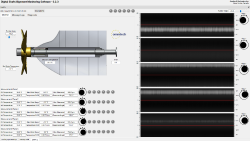DSAM - Digital Shaft Alignment Monitor

Project Origins
Omnitech Electronics developed the Digital Shaft Alignment Monitoring systems as a project collaboration with the American Bureau of Shipping (ABS).
The project started when ABS approached Omnitech Electronics to provide integration support for some off-the-shelf inductive proximity sensors.
At the time, ABS engineers were measuring propellor shaft alignment and dynamic positioning by installing analog proximity probes at positions inside the shaft bearings. The analog signals ran through bulkheads to a signal conditioning and digitization system. After provided integration support for two iterations of this setup, Omnitech Electronics suggested that a custom, digital, solution would offer better performance at a comparable cost. The analog sensors were no well suited for the pressurized oil environment and could not be properly calibrated after installation.
Omnitech Electronics invested resources to develop a digital proximity sensor purpose-built for the task. The sensor is pressure sealed, temperature compensated and digitized in-sensor. The digital sensors can be bused onto a single cable which reduced the number of bulkhead penetrators from the shaft bulkhead. Each sensor includes a fast-acting temperature sensor that monitors localized temperature increases.
DSAM system provides real-time, operating shaft position measurements and bearing condition monitoring for large vessels (shaft diameter over 500mm). DSAM measurements can be used by shipbuilders, owners and operators. Real-time, propeller shaft alignment, position and dynamic behaviour information can be monitored during construction, sea trials and operation of the vessel. Designed for large container ships and LNG vessels, the system combines shaft-bearing clearance and local bearing temperature measurements to assess multiple levels of warning and alarm conditions.
Shipbuilders can use the data to assess the proper alignment and operation of the shaft and bearings during construction and sea trails.
The monitoring system provides ship operators with real-time alarms that can prevent or reduce damage to the stern tube bearings from adverse operating conditions. Shipowners can use annual reports and data records to extend shaft inspection and maintenance schedules over the lifetime of the vessel.
Measurements

Shaft position and lubricant temperature are measured using an array of proximity sensors arranged in planes along each stern tube bearing. All measurements are digitized and calibrated in the sensor. Sensors are wired to a shared cabling harness that connects to a data distribution unit (DDU) located outside of the stern tube at each propeller. The DDU is connected and powered, through a single Ethernet connection to a Data Collection Unit (DCU).
The clearance measurements are factory calibrated to engineering units (nm) and include real-time temperature compensation. The measurements are digitized locally, inside each embedded sensor, thereby reducing any analog measurement error that may be induced through signal noise, temperature differences and cable losses. Temperature readings from each propeller are used with the shaft clearance measurements to monitor bearing conditions and help detect alignment or bearing wear problems early, in real-time. DSAM has been installed on vessels with shaft diameters between 0.6 and 1.0 m with total bearing clearances from 0.7 to 1.5 mm.
Highlights
- Up to 15 sensors per shaft
- Dual or single propeller configuration
- Retrofit version available for existing vessels
- Fully integrated bearing-embedded sensors for new construction
- 1000 samples per second, simultaneously on all channels
- One year of continuous data storage
- Single Ethernet cable between DCU and stern tube
- Designed for continuous immersion in pressurized oil
- Real-time monitoring stations
- Ship system integration options available
Data Collection Unit
All sensor data and power is sent from, and collected by, a central Data Collection Unit (DCU) typically located in the engine control room. The DCU logs data records and can redistribute the data over a network to additional operator displays. The DCU has inputs for Auxiliary sensors such as ship speed, rudder angle, water temperature, shaft rpm, and others. The DCU can read these sensors as analog inputs, ModBus, MQTT, or other protocols. The information is used by the monitoring software to adjust warning and alarm thresholds and to highlight ship operating conditions that may correlate with sensor alarms.
Real-time Monitoring Software
Operator station software provides a graphical display of bearing position history, clearance, temperature, warning levels and alarms. Additional ship information such as ship speed and rudder angle can be overlaid with the bearing data to view trends in bearing position and to highlight potentially damaging operating conditions.
The monitoring software warnings and alarms can be integrated into the ship control software through a comprehensive list of selectable interfaces including TCP, MODBUS, NMEA, relay contacts, and others.
Proximity Sensors
The DSAM's digital proximity sensors are custom designed by Omnitech Electronics for stable, long-term calibration and excellent measurement resolution. Sensors are calibrated for a shaft positon measurement range of 3 mm with linear accuracy better than 15 µm. Sensors also output uncalibrated reading vibration resolutions of < 100 nm. This high-resolution channel monitors resonant and harmonic vibration frequencies of the shaft.
Annual Reports and Maintenance
All warning and alarm conditions are recorded in a system event log with sensor data. This event log can be used to retrieve the corresponding sensor data for further analysis and to generate annual reports. Annual data analysis of the DSAM data can be used to adjust maintenance schedules.
Retrofit Existing Vessels with DSAM-Light
DSAM-Light is designed for retrofit installations on existing vessels where sensors cannot be embedded into the bearing design. DSAM-Light uses the same digital proximity sensors as the full system to measure shaft clearance at one or more positions along the stern tube. A 1-plane light system can be installed on most large vessels behind the aft propeller seal when the ship is docked. Additional measurement planes can be installed at bearing edges on most vessels when the shaft is removed.
Findings
The distributed, fast-acting (low time-constant) temperature sensors provided good insight into shafting performance on their own. Several
